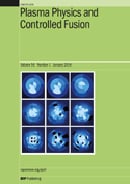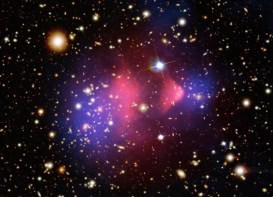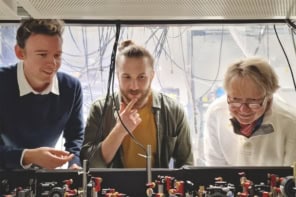Available to watch now, the IOP Publishing journal, Plasma Physics and Controlled Fusion, explores magnetic reconnection
Want to learn more on this subject?

Magnetic reconnection is a fundamental phenomenon in magnetic confinement fusion as well as in space plasmas. The fingerprint of reconnection is the formation of intense current sheets and the release and transport of energy on short time scales.
In the tokamak geometry of fusion devices like ITER, magnetic reconnection gives rise to the formation of magnetic islands which can develop at all scales (from a few millimetres to several tens of centimetres) with different consequences for confinement. Large centimetric islands can lead to the loss of confinement of plasma and cause the onset of major disruptions, leading to a degradation of the machine. Small millimetric islands can affect electron heat transport. At all scales, the presence of multiple islands leads to magnetic chaos which can modify the single-island scenario typically considered.
Analogously, in space plasmas, magnetic reconnection is recognized as an important process at different length scales ranging from the microscopic scale of plasma turbulence up to the global scales of planetary magnetospheres, solar and stellar flares, and accretion disks around black holes. In practice, magnetic reconnection allows the formation of solar flares and coronal mass ejections, which can propagate to Earth causing geometric storms, potentially disrupting satellite communications and electric grids.
The objective of this webinar is to bring together these two communities (fusion and space plasmas) working on magnetic reconnection and to highlight common issues that they both face.
Want to learn more on this subject?

Magali Muraglia (Chair) is associate professor at Aix-Marseille University since 2011. She received her PhD in plasma physics and astrophysics in 2009 at Aix-Marseille University with a work dedicated to “Multi-scales interaction between magnetic island and turbulence in hot magnetized plasmas”. She has since become an expert in theory and modelling of magnetized plasma and in magnetic reconnection processes. Recently, Muraglia has helped to originate the First European Conference on Magnetic Reconnection in plasma (https://ecmrp.sciencesconf.org), bringing together worldwide experts on magnetic reconnection from the fields of fusion and space plasmas to present and discuss their work.
Daniela Grasso is a senior researcher with the National Research Council at the Institute of Complex Systems in Turin, Italy. She is an expert researcher in analytical and computational plasma physics. She has been working for 25 years in the field of magnetic reconnection, both in fusion and astrophysical applications.
Myriam Hamed is a postdoctoral researcher at the Dutch Institute for Fundamental Energy Research (DIFFER) in the Netherlands. Her expertise lies in investigating turbulent transport phenomena in fusion research, particularly focusing on electromagnetic mode (micro tearing) turbulence. Myriam is developing a comprehensive quasilinear turbulence model, which aims to provide a better understanding of the turbulent transport by integrating accurate linear dispersion relation solutions with sophisticated saturation rules; effectively capturing the intricate nonlinear physics impacting turbulent fluxes. Her research methodology involves thorough comparisons between these models and gyrokinetic simulations, utilizing experimental data to validate and refine the models’ accuracy.
Giulia Cozzani is a postdoctoral researcher in the space physics research group at the University of Helsinki in Helsinki, Finland. Her main research interests are related to magnetic reconnection in space plasmas, particularly at the Earth’s magnetosphere. Since the beginning of her academic career, she recognized the importance of combining in situ spacecraft observations with numerical simulations to investigate complex plasma processes such as magnetic reconnection. For this reason, she has consistently aimed to become a versatile researcher capable of using both approaches. She received her PhD from Paris-Saclay University (École Polytechnique, Palaiseau, France) and the University of Pisa (Pisa, Italy) in 2019. She then spent two years at the Swedish Institute of Space Physics in Uppsala, Sweden, before joining the University of Helsinki in 2021. She is the recipient of the Vincenzo Ferraro Award 2022 and her PhD thesis has been published as a book in the Springer Theses “Recognizing Outstanding Ph.D. Research” series.
Hantao Ji is a professor of astrophysical sciences at Princeton University. He has been conducting laboratory experiments to study fundamental physical processes important to both astrophysical and laboratory plasmas, including dynamo effects, magnetic reconnection, magnetorotational instability (MRI), and other basic physical processes. Hantao graduated from University of Tokyo in 1990 with a DSc degree in physics. He was a research associate at National Institute for Fusion Science in Japan and University of Wisconsin – Madison before joining Princeton Plasma Physics Laboratory, where he rose to the rank of Principal Research Physicist in 2004. In 2013, he was appointed as a full professor at Department of Astrophysical Sciences. He was a recipient of the American Physical Society 2002 John Dawson Award for Excellence in Plasma Physics Research, and was elected as an APS Fellow in 2004.
Emanuele Poli is a staff member of the Tokamak Theory Division at the Max Planck Institute for Plasma Physics in Garching bei München, Germany. He was acting director of the division from 2014 to 2016 and is an adjunct professor at the University of Ulm since 2016. He received his PhD in theoretical physics from the University of Pavia (Italy) in 1999, with a thesis on paraxial electron-cyclotron (EC) wave beams. Since then, he was actively involved in the modelling of EC waves in several devices, including ITER and DEMO, and contributed to various aspects of the theory of high-frequency waves, in particular concerning methods for the description of beam scattering from density fluctuations in tokamaks. Recently, he has applied techniques borrowed from beam physics and nonlinear optics to the study of geodesic acoustic mode packets. The second focus of his research is the kinetic simulations of plasma instabilities like the tearing mode, considering both neoclassical processes and the interaction between disparate scales, like tearing modes and turbulence, and more recently between turbulence and fast-particle-driven modes.
Plasma Physics and Controlled Fusion is a monthly publication dedicated to the dissemination of original results on all aspects of plasma physics and associated science and technology.
Editor-in-chief: Jonathan Graves, University of York, UK and EPFL, Switzerland





